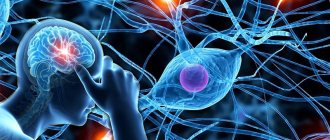Multiple sclerosis is an autoimmune disease of the central and peripheral nervous system, which is characterized by the disseminated formation of demyelinating pathological foci with the occurrence of symptoms in accordance with their localization. To this day, there are many questions regarding this pathology. What triggers an autoimmune process? What pathogenetic mechanisms underlie the disease? How to stop this process? Thanks to numerous scientific studies, it was possible to study many aspects of this pathology.
Previously, it was believed that multiple sclerosis mainly affects middle-aged people (30-50 years old). However, world statistics indicate an increase in the number of cases of demyelinating diseases among children. The proportion of multiple sclerosis in the age category from 0 to 16 years is about 1.2–6% of all patients.
The main pathogenetic link in the development of multiple sclerosis in children is a dysfunction of the immune system. As a result of exposure to trigger factors, a cascade of autoimmune reactions is launched. The synthesized T lymphocytes penetrate the blood-brain barrier and selectively destroy the myelin sheath of neurons and their axons. Fibrous plaques form in place of normal nerve tissue. The number of demyelinating foci and their size are determined by the activity of the pathological process.
In multiple sclerosis, not only the nerve cells of the central nervous system, but also the peripheral ones, succumb to autoimmune aggression. This statement was a real discovery in neurology. If just a few years ago disorders of the peripheral nervous system excluded the diagnosis of multiple sclerosis, today such variants of the course of the disease have been scientifically confirmed.
Causes of multiple sclerosis
The main pathogenetic mechanism of this disease is the sensitization of T-lymphocytes by myelin antigens and the activation of autoimmune reactions against their own nerve cells. It has not yet been possible to reliably establish the reasons for this process. There are several predisposing factors that can initiate a cascade of pathological immune response. These include:
- Infectious agents . According to this hypothesis, some viruses (adenoviruses, herpes viruses, mumps, measles) can trigger the synthesis of antimyelin antibodies. The genetic material of viruses is represented by a chain of nucleic acids. Some of its parts coincide with myelin proteins. Thus, antigen-presenting cells (APCs) perceive their own genetic material as foreign. After the exchange of information between APCs and T cells, an autoimmune reaction is launched against the myelin sheath of neurons and oligodendroglia, and inflammatory cytokines (interleukin-2, tumor necrosis factor, interferon gamma) are synthesized in the pathological focus, which lead to destructive processes.
- Heredity . According to statistics, the risk of multiple sclerosis in a child whose family has had a case of this disease is higher than in the general population.
- Environmental factors . The results of some studies confirm the fact that multiple sclerosis is more common in residents of geographical zones remote from the equator. This is explained by the low amount of vitamin D in representatives of the Caucasian race compared to residents of equatorial regions.
- Vaccination of children against hepatitis B and stress factors are not reliable reasons for the activation of autoimmune aggression.
Clinic and diagnosis of optic neuritis in children with multiple sclerosis
The disease usually affects young and middle-aged people. In recent years, MS has become increasingly diagnosed in children, which may be due to improved early diagnosis with the advent of magnetic resonance imaging, electrophysiological studies, as well as an increase in the incidence of MS. Until recently, it was not customary to give such a diagnosis to a child, especially under the age of 10 years. Typically, these patients were diagnosed with leukoencephalitis of various origins, including Schilder leukoencephalitis, leukodystrophies, recurrent optic neuritis, etc. Currently, the literature contains a large number of descriptions of MS in children under 10 years of age. According to some authors, MS in 5% of patients can begin in childhood. The earliest case of reliable MS is considered to be a case of the disease in a 10-month-old girl; descriptions of the disease in children under 5 years of age are quite common. When the disease begins in the first year of life, MS is characterized by an extremely unfavorable course of the process. Moreover, in 30% of children the initial diagnosis was isolated optic neuritis. Data are presented when, among 55 children with the onset of MS before 6 years of age, optic neuritis (ON) was subsequently observed in all of them, some 2–3 times. A review of the frequency of onset of MS in childhood in various regions of Russia showed that its frequency ranges from 2 to 10% and that damage to the brain stem and optic nerve is typical for children. Among optic nerve (ON) pathologies, optic neuritis occurs in 30–40% of cases. The etiology of ON is diverse - infectious diseases (bacterial and viral), tumors and inflammatory diseases of the brain, infections of the paranasal sinuses, vascular disorders, alcohol and other intoxications. Cases caused by chlamydia, brucella, cat scratch virus, collagenosis and tuberculosis have been described. Most researchers believe that in 80% of patients, ON may be the first, and sometimes the only, manifestation of MS, while in 13% of cases, ON occurs against the background of the general clinical picture of MS. The course of MS is very diverse; it is no coincidence that in the literature it is called an “organic chameleon”. The pathogenesis of MS, despite more than 150 years of study, and its etiology remain unclear, which makes treatment difficult. The priority for describing the clinical picture of MS belongs to Jean Martin Charcot (1825–1893). Charcot described the first case of MS in 1856, and in 1886 he justified the separation of MS into a separate nosological form. It is believed that the cause of the development of MS is a complex of hereditary and environmental factors. The theory of multifactorial etiology of MS implies that for the development of the pathological process, external influences (for example, viral infection) are necessary, which act as triggers. Considering the high prevalence of ON, its relationship with the pathology of the central nervous system, and the general pathogenetic mechanisms of the development of nerve fiber damage, it becomes clear that it is necessary to understand the processes that occur in the tissues of the central nervous system in order to timely prescribe pathogenetically oriented therapy for the prevention of blindness and disability. It has been established that MS is based on a whole cascade of immunopathological reactions leading to the destruction of myelin in the acute stage of the process and the formation of foci of sclerosis (“plaques”) in the chronic course. Similar changes occur in the optic nerve. Some researchers believe that ON is an isolated form of MS. When ON occurs after 5–7 years, MS occurs in 45–75% of cases. A feature of ON in MS is the destruction of myelin, a special type of plasma membrane that forms the sheath around axons. The functions of the myelin sheaths in peripheral nerves and nerve fibers of the brain and spinal cord are diverse: participation in the transmission of nerve impulses, barrier, support, trophic and participation in immunological reactions. Myelin-oligodendrocyte protein is of great importance in the induction of demyelination in MS due to its influence on both cellular and humoral immunity. Another myelin protein with antigenic properties, alpha-B-crystallin, first isolated from the lens of the eye, is one of the most powerful human immunogens, and a specific response to it can be at different stages of MS development. This peptide appears under various pathological conditions: stress, heat shock, poisoning, hypotension, intoxication, etc. Myelin (lipoprotein membrane) contains phospholipids, glycoproteins, and steroids. Gangliosides are involved in the reception of toxins, differentiation of nerve cells, myelogenesis and the conduction of nerve impulses. In demyelinating diseases, ganglioside metabolism is disrupted. Of greatest interest from an immunological point of view are myelin-associated glycoprotein and myelin-oligodendrocyte glycoprotein, which have immunogenic and encephalitogenic properties. They are responsible for stabilizing the membrane, for the interaction between the layers of the membrane, and since they are located on the cytoplasmic side of the membrane, they are normally inaccessible to the immune system. During inflammatory processes and damage to the blood-brain barrier (BB), the protein interacts with the immune system. A special feature of the protein is its high concentration of sulfur-containing amino acids. Infectious agents may be involved in the development of demyelination in MS due to nonspecific damage to myelin during the immune response to this agent or through polyclonal activation of immunocytes, including those specific to myelin antigens. Local inflammatory and autoimmune processes developing in the white matter of the brain and the optic nerve are accompanied by cellular reactions to self-antigens associated with increased production of activation cytokines, which determine the type and duration of the immune response, control cell proliferation, angiogenesis, hematopoiesis, inflammation and many other processes , being mediators of intercellular interaction in the immune system. An imbalance in the cytokine system leads to uncontrolled activation of “forbidden” clones of lymphocytes sensitized to myelin antigens, which leads to a breakdown of tolerance and autoimmune reactions. The main mediators of the chronic pathological process in MS are considered to be the cytokines g-interferon, tumor necrosis factor alpha (TNF-a), lymphotoxin, interleukins: IL-1, IL-2, IL-12, IL-15. Increased production of these cytokines by monocytes and Th1 helper cells in MS is combined with a decrease in the synthesis of anti-inflammatory cytokines, which reduce the activity of cellular immune reactions. These cytokines are produced by another population of T cells (Th-2 cells) and include interleukin 4, 10, a and b interferons, transforming growth factor beta (TGF-b). Pro-inflammatory cytokines regulate the production of chemokines, the main functions of which are the formation of many types of cells: leukocytes, platelets, endothelial cells, epithelium, fibroblasts, etc. During the process of inflammation, the migration of polymorphonuclear leukocytes occurs, which are the initiator of lipid peroxidation (LPO) and contribute to the accumulation of LPO products , which leads to damage to healthy tissue, an increase in inflammation, and increased permeability. The course of the pathological process in the early stages of plaque formation is accompanied by the penetration of peripheral blood lymphocytes into the brain tissue. Passing through the BBB and coming into contact with glial cells, they are activated and produce inflammatory cytokines, attracting more and more blood lymphocytes. Nonspecific and specific reactions complement each other, which causes an avalanche-like local inflammatory reaction and myelin destruction. Damage to the BBB by the resulting immune complexes and cytokines leads to a breakthrough in the flow of inflammatory mediators and cytotoxic lymphocytes, to cell destruction and the release of lysosomal enzymes from leukocytes, serotonin from platelets, histamine from mast cells and other mediators, thereby increasing the processes of inflammation. Clinical symptoms in MS Clinical symptoms in MS are the result of damage to nerve fibers and myelin when the conduction of nerve impulses is disrupted. In this case, various parts of the central nervous system are affected, most often the white matter around the ventricles of the brain, in the cerebellum, brain stem and cervical spinal cord. The optic nerves are especially prone to demyelinating lesions. As mentioned above, optic neuritis is a common manifestation of MS, and 80% of patients with ON subsequently develop MS. Active observation of patients with unilateral ON after 15 years revealed significant MS in 60% of cases. Magnetic resonance imaging (MRI) provides great assistance in the early diagnosis of MS and determining the prognosis in the presence of ON. Thus, in patients with monosymptomatic ON, MRI in 40–70% of cases revealed foci of demyelination in other parts of the brain. The presence of periventricular disorders during MRI is detected in 98% of cases, and these changes are not always clinically manifested. When examining the orbital segment of the optic nerve (ON), signal enhancement was noted in 78–89% of patients with papillitis or ON with abnormal VEP. MRI signal intensity in the acute phase allows predicting the functional outcome of the disease. With extensive and persistent MRI defects, the prognosis for vision is worse. It is important that in almost 50% of patients an increase in the signal from the clinically intact eye and an expansion of the subarachnoid space due to edema of the distal segment of the optic nerve were detected. In more than 70% of patients with ON, retrochiasmatic lesions were found in the area of the lateral geniculate body, visual radiation and visual cortical centers. The most common symptom of brain stem damage is oculomotor disturbances, which may be accompanied by complaints of double vision. Characteristic of MS is internuclear ophthalmoplegia syndrome, associated with foci of demyelination in the posterior longitudinal fasciculus system. Typical for MS are discoordinated movements of the eyeballs, their disparity vertically or horizontally (strabismus), and failure to bring the eyeballs inward and outward. A typical lesion of the upper brainstem is vertical nystagmus. Often with MS, horizontal nystagmus, asymmetrical nystagmus with a rotatory component, “saccade” movements of the eyeballs, and unilateral nystagmus are observed. The classic picture of ON (regardless of the etiology) is characterized by an acute decrease in vision over several hours, sometimes within 1–2 days or weeks. Changes in vision are usually accompanied by the appearance of a central or paracentral scotoma, narrowing the visual fields by 10–30%. Decreased vision is accompanied by a change in color vision with loss of tone and color, a predominance of gray, and a narrowing of the visual field to green and/or red. Patients may notice a difference between depth perception and stereoscopic vision, which is a pathognomonic feature of MS. There is a flickering of objects and a disturbance in the perception of a rapidly moving object. Patients are concerned about increased sensitivity to bright light. Loss of brightness and impaired contrast are detected in more than half of MS patients. The diagnosis of retrobulbar neuritis is made when, against the background of visual disturbances, patients complain of pain that increases with eye movement or when pressing on the eyeball, especially when looking up. Painful sensations are associated with irritation of the membranes of the optic nerve during traction by the bases of the superior and internal rectus muscles. Pain may persist for hours or days and may precede or accompany vision loss. A common symptom is headache, localized in the fronto-parietal or fronto-occipital regions. An important clinical symptom of ON is a violation of pupillary reactions, manifested by sluggish pupillary reaction or even a paradoxical reaction - constriction of the pupil to light during prolonged illumination. When retrobulbar neuritis occurs for the first time in the first weeks, as a rule, no changes are noted in the fundus. The fundus picture depends on: the localization of the process in the optic nerve; intensity of inflammatory changes; prescription of the process. With papillitis, the optic disc is hyperemic, the boundaries are erased, and swelling is noted, sometimes pronounced due to collateral edema. Already in the acute stage of ON, signs of descending atrophy of the optic disc may appear: blanching of the temporal halves of the disc (the papillo-macular bundle mainly suffers), narrowing of the arteries and dystrophic changes in the macular area. Clinical papillitis is observed in 35% of MS patients. In this case, along with the described symptoms, exudate may be observed in the area of physiological excavation of the disc, along the veins of the perivasate in the form of couplings, in the macula - edema, small lesions, serous detachment of the pigment epithelium. Along the edge of the disc, slit-like retinal defects are detected, indicating the presence of atrophy of the retinal nerve fiber layer, and these changes are detected in 70% of patients with MS without a history of visual impairment. An increase in the magnetic resonance signal in any ON is associated with vasogenic edema as a result of increased BBB permeability, with a major role played by disruption of antegrade axoplasmic transport in axons. Decreased vision in ON is caused by the occurrence of a conduction block due to impaired BBB permeability without demyelination or axonal degeneration. Conduction delay detected by VEP may occur before clinical manifestations. Subsequently, as a result of ischemia, compression and exposure to toxic products, axonal destruction occurs, which leads to partial optic nerve atrophy (PANA) in 35–50% of patients. In MS, the course of ON has a number of features: the development of bilateral and repeated (recurrent) retrobulbar neuritis, as a rule, subsequent restoration of vision (complete or partial); subclinical changes in the fundus and changes in VEP in 80% of patients; changes in VEP, visual fields for the intact eye with unilateral ON; the presence of a transient decrease in visual acuity, color perception and changes in visual fields under the influence of external factors, for example, increased body temperature (Uhthoff phenomenon); decreased contrast sensitivity in the region of high spatial frequencies. And, as stated, MRI provides the greatest assistance in diagnosing ON in MS. ON in MS is more often detected in females, there are geographical features of the disease, seasonality of the disease: autumn-spring and winter. It is important to combine a number of pathological signs in patients with monosymptomatic ON to predict the risk of developing demyelinating diseases of the central nervous system. Thus, 35% of patients have Sjögren's syndrome, decreased corneal sensitivity, and oculomotor disorders. In rare cases, people with MS have uveitis. A survey of 2628 patients with MS (USA) revealed uveitis in only 1% of cases, panuveitis in 39.3%, planitis in 35.7%, iridocyclitis in 14.3%, and choroiditis in 10.7% of cases. Planitis was accompanied by active inflammation and exudation. In 78.5% of patients, uveitis had a remitting course. In general, the incidence of uveitis in MS patients is 10 times higher than in the general population, indicating the possibility of cross-reaction of activated immunocytes to choroidal antigens. Cases of neuroretinitis have been described, especially in children, with severe exudation around the macula. Research by I.Z. Karlova (1997) convincingly proved that in patients with ON against the background of MS, changes in the immunoregulatory index of the immunodeficiency type were detected in almost 40% of cases and similar autoimmune conditions were detected in 25%, and a pronounced deficiency of B lymphocytes was noted in 58 % of patients with acute ON and up to 70% with recurrent course. The detected high levels of immunoglobulin D in the tear fluid in ON in 63% of cases, as well as the presence of antibodies to myelin basic protein (up to 53%) and nDNA, indicate the activity of the pathological process and damage to the optic nerve of patients with MS. Treatment of ON in MS Treatment of ON in MS is one of the urgent and complex problems due to the fact that the etiology of the disease is not yet clear. There is currently no etiotropic treatment, and the entire complex of therapeutic effects for ON can be divided into two main groups: pathogenetic therapy and symptomatic therapy. Pathogenetic therapy is aimed at preventing the destruction of optic nerve and brain tissue by activated cells of the immune system and toxic substances, restoring myelin, pathways, retinal neurons, and improving the trophism of brain tissue. Symptomatic therapy is aimed at maintaining and correcting the functions of the damaged system, compensating for existing disorders. In case of exacerbation of the disease, corticosteroids and adrenocorticotropic hormone (ACTH) drugs remain the drugs of choice. Glucocorticoids reduce antibodies, delay the decay of acid glycosaminglycans, thereby exerting a pronounced anti -inflammatory effect, reducing the permeability of capillaries, they cause decongestant effect. Currently, the drug methylprednisolone is most widespread. It was established that immunosuppressive and anti -inflammatory influence is most effective in a short period of time the day before and in the acute stage of exacerbation of RS. The use of methylprednisolone intravenously in pulse -doses for 3-7 days, followed by the prenisolon course, reduces relapses 2 times in the subsequent 2 years of observation. Methylprednisolone is introduced drip intravenously at 0.5–1.0 g daily. After that, it is possible to conduct a short supporting course of prednisolone inward, starting with 15–20 mg every other day and reducing 5 mg. It is treated with the introduction of dexamethasone at 1.0 ml in a short course 1 time per day of retrobulbarno 5-10 days, as well as prolonged drugs - diprospanal and kenalog. The most effective administration of drugs through the irrigation system into a retrobulbar space, leading to an increase in visual acuity on 2-3 days of treatment. Along with hormonal preparations, the patients are administered local through the irrigation system (indetric, trasilol) - kallikrein - tripsin inhibitor. Considering that at the peak of inflammation, the kinin system with the release of protease occurs, the use of these proteolysis inhibitors has a greater therapeutic effect in the initial stages of the inflammatory process. Antioxidant drugs are necessarily prescribed: Essential, Emoxypin, Vitamin E. A constant drug in treatment for local and general use is dicinon. At the same time, not only its angioprotective effects are taken into account, related to the influence of the capillaries on the endothelium and the main substance of intrandothelial spaces, but also a pronounced inhibitory effect on the products of the floor and the activity of the kinin blood system. The high antioxidant activity we found in 1986 (600 times higher than ascorbic acid) in many ways explained its good therapeutic effect, with it. The drug is administered into the type of retrobulbar injections of 0.5 ml or through an irrigation system of at least 10-15 injections, if necessary, additionally intramuscularly and inside in tablets. Reception of dicinon lasts at least 3 weeks. Observation of patients showed the high efficiency of the combined use of retrobulbar injections of Gordoxes, Dicinon and Dexamethasone. With a debut, it is already necessary in the first hours of the patient’s admission to the hospital to take measures that prevent the development of irreversible changes in the optic fibers, due to edema and exudation. Dehydration therapy is urgently prescribed, including diacarb inside once a day in the morning. Re -reception does not cause a diuretic effect during the day, since an excess of bicarbonates disappears. Diacarb is taken courses for 4-5 days with intervals of 2 days. In the early days, it is possible to introduce a furosemide of 0.5–1.0 ml. It seems effective the use of diploma -adrenaline blocks of the middle nasal passage, which are carried out every other day, 5 procedures for treatment. The Turunda is impregnated with a solution of savage 0.5% and adrenaline 0.1% (1 ml of dicain solution is added 1 drop of adrenaline), the duration of the procedure is 15–20 minutes. Anti -inflammatory therapy includes the prescription of drugs from a group of non -steroidal anti -inflammatory drugs (Indomethacin, Metinol and others). Antihistamines are prescribed. Preference is given to Pipolphene, which also has a pronounced antioxidant activity (150 times higher than ascorbic acid). It is advisable to use it in the presence of uveitis, retinovasculitis, papillitis with pronounced exudation, taking into account its ability to lower vascular permeability, antihistamine, cholinolytic and adrenolytic effects. The course is 2 weeks with a change in the drug. In the future, it is also better to prescribe phenotiazin derivatives, as they have a strong antioxidant effect. In recent years, to improve metabolism in the tissues of the eye in it and their consequences - chans, retinal dystrophy in complex therapy, carbogen is used. Inhalation of small concentrations of carbon dioxide with oxygen leads to an improvement in microcirculation in the damage zone and improving tissue respiration. In addition to corticosteroid preparations, it is possible to use synakteen -depo, ACTH, the main advantage of which is a small amount of side effects and maintaining endogenous steroids. With a pronounced deficiency in the system of T -limphocytes, observed more often in long -suffering patients, the prescription of Timus drugs is shown: T - T - T -activine, Timaline, Timopentin and their analogues. Since in patients with PS the products of interferons were reduced, it is possible to prescribe interferon inducers (dibazole, half -Dodan, propmil), as well as natural interferons (interferon, reoperone). The use of neuroimmunomodulators is considered promising. It is known that endogenous opioid peptides can participate in the process of transferring information from the nervous system to the immune. Moreover, they themselves are components of the immune system: some cells of the immune system are able to produce opioid peptides, and some mediators of the immune system have opioid activity. Given their influence on the metabolism of a number of biologically active substances, neuronal conductivity, immunomodulating effects, it is advisable to use the synthetic analogue of leiunkyfalin - Dalargin. The most famous property of Dalargin is its ability to stimulate tissue regeneration, normalize microcirculation in the inflammation zone, increase the body's immune properties. Dalargin is used in the form of intramuscular injections, the course dose is 30–40 mg, one -time 1 mg. In case of normalization of metabolism in the wall of blood vessels, reducing tissue hypoxia, removal of edema, normalizing permeability and improving microcirculation both in the acute course of the process, and in the stage of remission, along with dicinon, angioprotectors as tonsillitis, prodectin, parmidin, and doxium are used (at the same time Their ability to reduce the activity of bradykinin) is taken into account). With optical neuritis with a pronounced hemorrhagic component, exudation, retinovasculitis, uveitis, preference is given to Ditsinon. It is possible to use epsylon -aminocapronic acid (kinin and plasmine inhibitor). For capillary proprivers, vitamin P, ascorbic acid, non -steroidal anti -inflammatory drugs are required. When the acute inflammatory phenomena are subsided, it is already in the early stages in order to prevent complications to begin neurotrophic therapy aimed at improving the airbreak in the optic nerve, retina, vascular membrane, and the normalization of tissue metabolism in these structures. Especially early recovery therapy is necessary in the presence of papillitis, retinal edema, the development of dystrophic foci on the fundus. In a complex of agents that improve the trophic of these structures of the eye, drugs such as taufon, sermion, cytochrome -s, Galidor, Stugeron, Cavinton, Kavinton, Kavinton, but - Shpa, Theonucle, Nicotinic acid, vitamin therapy, etc. are widely used. The preference is given to the local administration of the drug Depending on the localization of inflammation and its character. Electro, phonophoresis, magnetophoresis, endonasal electrophoresis are widely used. Given the high tropiness of cerebrolysin to nervous tissue, the ability to improve the metabolism of the retina (increasing the efficiency of aerobic energy metabolism, the effect on the biosynthesis of protein neurons, ensuring neuroprotection due to a decrease in the level of lactic acid) and, as our studies showed (Guseva M.R., Dubovskaya L.A.A. ., 1995), the ability to regenerate retinal neurons, it is advisable to use it with it not only in the form of intramuscular injections, but must be through the irrigation system 5-6 times a day for 7-15 days or retrobulbarno in injections on average 10– 15 days. Locally, the drug is administered in a single dose of 0.5 ml. This introduction is exhausting the high concentration of the drug for a long time and leads to good treatment results. It seems appropriate to prescribe to patients with PC such drugs as nootropil, encephalus actively affecting the metabolism of nervous tissue. With a long course, it is advisable to use heparin, taking into account the fact that heparin • is an antagonist of histamine; • normalizes pathological changes from lipoproteins and blood chilomicrons; • possessing the properties of acidic glycosaminglycans, is in the body in combination with proteins, participates in water -salt metabolism, changes the colloidal state of the basal membranes of the vessel wall; • due to the similarity of the chemical structure with hyaluronic acid and chondroitin sulfate, it acts as a microbial and tissue hyaluronidase inhibitor, regulating directly tissue and vascular permeability (heparin -hyaluronidase -hyaluronic acid system); • is a non -specific plasmin inhibitor, which is of great importance in eliminating tissue destruction during inflammation; The outcome of it is the development of atrophy of DNS, therefore, along with the prescription of neurotrophic therapy and biostimulants, patients are indicated by electrostimulation of ZN, acupuncture. The new direction of pathogenetic treatment of RS is stimulation of remote. To do this, use factors that can stimulate proliferation and differentiation of oligodendrocytes. The answer of glial cells to various growth factors depends on the state of the cell itself, the degree of its maturity or damage, on the state of neurons and other glial elements. On mature glial cells, some growth factors can act damaging. The same problems are relevant when transplanting glia into affected areas of the brain, for example, when transplanting Schwann cells into the tissue of the spinal cord. Currently, the possibility of transplanting the predecessors of oligodendrocytes to the foci of demyelinization to stimulate remelineization is currently evaluated. Recently, one of the promising methods of immunocorrection is the transplantation of bone marrow cells. This treatment method is now actively examined in various autoimmune diseases, as it can significantly reduce the amount of immunocompetent cells sensitized to various autoantigens. It is assumed that developing T -cells acquire tolerance to their own antigens, including Milin antigens, which leads to blocking autoimmune reactions. It is believed that this method can be regarded as a method of emergency therapy of RS with a progressive, malignant course of the disease. Literature 1. M.R. Guseva, I.M. Mosin, T.M. Tetsovrebov, I.I. Bushev. Features of the course of the optic neuritis in children. Abstract. 3 All -Union Conference on Actual Issues of Pediatric ophthalmology. M.1989; N.136–138 2. E.I. Sidorenko, M.P Guseva, L.A. Dubovskaya. Cerebrolysian in the treatment of partial optic atrophy in children. J. Neuropathology and Psychiatry. 1995; 95: 51–54. 3. M.R. Guseva, M.E. Guseva, O.I. Maslova. The results of the study of immune status in children with optic neuritis and a number of demyelinizing conditions. Book The age characteristics of the organ of vision are normal and pathologists. I., 1992, p. 58–61 4. E.I. Sidorenko, A.V. Plotatova, M.R. Guseva. Diagnosis and treatment of optical neuritis in children. Guidelines. M., 1992, 22 p. 5. M.R. Guseva, L.I. Filchikova, I.M. Mosin et al. Electrophysiological methods in evaluating the risk of developing multiple sclerosis in children and adolescents with monosymptomatic optical neuritis of g. Noneropathology and psychiatry. 1993; 93: 64–68. 6. I.A. Zavalishin, et al. Pathogenesis of retrobulbar neuritis. J. Neuropathology and Psychiatry. 1992; 92: 3-5. 7. I.M. Mosin. Differential and topical diagnosis of optical neuritis in children. Dis. Kand. Med. Nauak (14.00.13) Mosk. Helmholtz M., 1994, 256 s, 8. M.E. Guseva clinical -paraclinical criteria for demyelinizing diseases in children. Abstract dissens.K.M.N., 1994 9. M.R. Guseva Diagnostics and pathogenetic therapy of uveites in children. Diss. Doctor Med. Nauk in the form of a scientific report. M.1996, 63 p. 10. I.Z. Karlova clinical and immunological features of optical neuritis in multiple sclerosis. Abstract dissens.K.M.N., 1997 11. E.I. Gusev, T.L. Demina, A.N. Boyko. Multiple sclerosis. M., 1997, 463C 12. M.R. Guseva, S.Yu. Boyko, O.I. Maslova. The results of clinical and immunogenetic. examinations for optical neuritis in children with reliable multiple sclerosis. Neurological Journal. 1999; 5: 10-15. 13. L.V. Kovalchuk, L.V. Gankovskaya, E.I. Rubakova. The system of cytokines. M., 1999; 74 p.
Types of multiple sclerosis
This disease in children is classified according to the clinical course of the disease:
- Remitting-relapsing variant of the course . Episodes of increasing neurological deficit of the disease are followed by periods of partial or complete recovery. During an exacerbation, the neurological deficit increases gradually over several days to several weeks, exacerbation reaches a plateau phase, and then the impaired functions are gradually restored over several weeks or months. In some cases, the exacerbation reaches its maximum within a few minutes or hours. It should be noted that during this course of the disease, in some patients the symptoms that arise do not resolve completely, and the neurological deficit increases over the years.
- Primary progressive variant of the course . After the onset of the disease, gradual progression of the pathology is observed. There may be “bright gaps” in the clinical picture.
- Secondary progressive variant of the course . Against the background of alternating periods of remission and relapse, a secondary increase in the clinical manifestations of the disease is observed.
- Progressive course with periods of exacerbation . The increase in clinical signs of the disease begins with its first manifestations. The progressive course is accompanied by severe periods of exacerbation.
Symptoms of Multiple Sclerosis
The clinical picture of this disease in children is very variable and depends on the location of the focus of demyelination and the course of the disease. Early signs of pathology are nonspecific and are often missed by parents. The main symptoms of multiple sclerosis in children include:
- A constant feeling of general fatigue , which does not depend on physical activity and daily routine. Children become inactive and stop playing with toys and other children.
- Visual impairment . Children often complain of the appearance of a “mesh before the eyes,” double vision, decreased visual acuity, and pain when moving the eyes. Sometimes visual fields are lost and color perception is impaired. Such episodes last more than a day with subsequent restoration of vision. With dystrophic changes in the optic nerve, irreversible damage occurs. When the oculomotor cranial nerves are damaged, strabismus and nystagmus occur.
- Local muscle cramps . They appear suddenly and disappear just as quickly.
- Hearing loss occurs when the auditory nerve or central auditory analyzer in the temporal lobes of the brain is damaged.
- Movement disorders such as central paralysis (increased muscle tone, decreased strength in the limbs, hyperreflexia, the appearance of pathological reflexes). Abdominal reflexes disappear in multiple sclerosis. Any type of paresis is possible: paraparesis, hemiparesis, monoparesis, tetraparesis. A characteristic feature of motor deficits in multiple sclerosis is variability. Weakness in the limbs waxes and wanes throughout the day.
- Cerebellar symptoms : impaired balance and coordination of movements, intention tremor, scanned speech, etc.
- Disorders of the sensitive area . The most common manifestation of this syndrome is a sensation of “crawling on the skin” or “tingling”. This symptom is called paresthesia. First of all, deep sensitivity suffers (muscular-articular, vibration, kinesthetic). A characteristic sign of sensory impairment in multiple sclerosis is the occurrence of paresthesia in the spinal region when the head is tilted forward.
- Dysfunction of the bladder and lower intestines are the most common reasons why parents of patients consult a doctor. Acute urinary retention or incontinence, neurogenic constipation or fecal incontinence significantly reduce the child's quality of life. These symptoms are associated with a loss of “central” control over the detrusor and sphincters.
- Cognitive and psychological disorders . Children's performance at school worsens, they become inattentive and irritable, and sometimes unemotional and depressed.
For multiple sclerosis, it is impossible to identify separate “classic” symptoms. Each sign of the disease correlates with the location of the degenerative process in the nervous system. Therefore, recognizing the disease in the early stages is very difficult. Especially in children, who are not always able to objectively assess their feelings.
Variants of the course and symptoms of the disease
Most patients suffering from multiple sclerosis have an undulating course of the disease, which is characterized by periods of remission and relapse. Relapses are characterized by the appearance of new symptoms.
An increase in body temperature may aggravate the clinical picture of the disease, but such a condition is not considered a true relapse.
In patients with an undulating course of the disease, a steady progression of symptoms of damage to the nervous system develops within 10-20 years from the onset of the disease with periods of remission. This type of multiple sclerosis is called secondary progressive.
Primary progressive multiple sclerosis progresses steadily without periods of remission.
The clinical picture varies greatly from patient to patient depending on the level of involvement.
Symptoms of movement disorders:
- Numbness of the body, usually on one side, which may start in the arm or leg;
- Trembling, loss of coordination, unsteady gait;
- Lhermitte's sign is a sudden, short-term painful sensation when tilting the head forward (“electric shock”).
Patients often complain of changes in their vision:
- Pain when moving the eye, partial or complete loss of vision;
- Diplopia (double vision);
- Blurred vision.
Symptoms of MS may also include the following:
- Increased fatigue;
- Unintelligibility, unclear speech;
- Dizziness;
- Painful and tingling sensations in the body.
Diagnosis of multiple sclerosis
Diagnosis of the disease involves visualization of foci of demyelination of the central nervous system using instrumental research methods (MRI with the introduction of intravenous contrast), confirmation of the autoimmune activity of the body after specific immunological tests and determination of functional disorders. MRI is considered the “gold standard” in diagnosing multiple sclerosis. This method allows you to identify the slightest foci of demyelination. MRI with contrast gives a clear picture of the pathology, in which the “old” and “new” foci of demyelination differ from each other. Based on these data, one can judge the activity of the disease.
Immunological tests are carried out to assess the activity of the pathological process. The biological material for these tests is mainly cerebrospinal fluid or blood. Detection of lymphocytic pleocytosis and increased myelin levels are nonspecific signs of multiple sclerosis.
An extended blood immunogram allows you to identify those disorders of the immune system that have become critical in the development of demyelinating disease of the nervous system.
The evoked potential method is becoming increasingly important in the diagnosis of multiple sclerosis. It allows you to detect demyelination of neurons at the initial stage of the disease. After analyzing the nature of the passage of the electrical impulse from the peripheral receptor to the central analyzer, the degree of damage to the components of this circuit is determined.
To verify the diagnosis of multiple sclerosis, W. McDonald’s diagnostic criteria are used all over the world. They compare the number of symptomatic episodes (attacks) and the conclusion of magnetic resonance imaging (MRI).
All results of additional research methods must correspond to the clinical picture of the disease. Multiple sclerosis is characterized by transient episodes of nervous system dysfunction that last at least 24 hours. Symptomatic attacks should appear no more than once a month.
Recent decades have been marked by significant advances in the clinical picture, diagnosis and pathogenetic treatment of multiple sclerosis (MS) in children [1-3, 6]. However, studies on predicting the development of MS after the onset of demyelination in childhood are few and require further development [4, 6].
The purpose of this study is to determine risk factors for the development of MS in children after the first episode of demyelination based on studying the nature and extent of damage to the nervous system, taking into account the immune status of patients.
Material and methods
We conducted a retrospective assessment of the neurological status, neuroimaging data and immunological studies in 67 children during the debut of the demyelinating process.
The main group consisted of 30 patients with confirmed MS [2].
The comparison group included 37 children with other diseases of the nervous system, in whom in 75.7% of cases there was a single episode of demyelination, the remaining 24.3% of patients with monofocal lesions had a polyphasic course of the disease (recurrent optic neuritis) [5]: 23 patients with isolated optic neuritis, 5 with transverse myelitis, 5 with brainstem lesion syndrome, 2 with ataxic syndrome, 2 with diffuse symptoms of pyramidal, sensory, cerebellar disorders and damage to the cranial nerves. To name this group of patients, taking into account the special pathomorphological mechanism of development of their disease, we used the term “demyelinating syndrome” (DS).
All patients had their neurological status examined and magnetic resonance imaging (MRI) of the brain and/or spinal cord was performed in T1, T2, and FLAIR modes. The study of immunological parameters was carried out in 17 children aged 8-14 years: 8 with MS and 9 with DS. In these cases, indicators of cellular and humoral immunity were analyzed and indicators of phagocytosis were determined. Immunological parameters in patients were assessed in relation to those in a group of healthy children comparable in age (21 people).
Statistical data processing was carried out using the Statistica 6.0 software package. Mann-Whitney and Fisher tests were calculated to compare groups. The p value was chosen as the threshold level of statistical significance
<0,05.
Results and discussion
The age of patients at the time of the onset of the first clinical symptoms of the disease in the MS group was 13.2±0.7 years, in the DS group it was 10.5±0.6 years ( p
<0.01). In children with MS, the onset most often occurred at the ages of 8-14 (56.6%) and 15-17 (40%) years, and in DS - during the school period (73%), i.e. at 8-14 years old.
Girls predominated in both groups (60% versus 40% in MS and 70.3% versus 29.7% in DS, p
=0,27).
The main syndrome of the disease was determined by focal damage to the nervous system. The monosymptomatic onset significantly prevailed over the polysymptomatic one in both children with MS (76.7%) and DS (81.1%). From the table 1
It follows that the leading manifestations of the onset in MS were symptoms of damage to cranial nerves and movement disorders, and in DS - optic neuritis.
Comparison of the frequency of individual neurological symptoms showed that in MS, coordination disorders significantly predominated (33.3% compared to 8.1% in DS, p
= 0.01), nystagmus (20% versus 2.7%,
p
= 0, 03) and upper flaccid monoparesis (occurred only in patients with MS with a frequency of 16.7%).
Retrobulbar neuritis, especially with its bilateral localization, on the contrary, was significantly less common in MS ( p
<0.01).
On MRI in the group of patients with DS, in the majority (51.6%) of cases there were no focal changes in the nervous system or there were single foci of demyelination (38.7%). In MS, in 93.3% of cases, multiple foci of demyelination were observed with typical dissemination in space. The identified foci in children of this group were characterized by a round or oval shape and the presence of a clear contour. Every 5th patient had “Dawson’s fingers” changes and showed signs of active autoimmune inflammation (accumulation of contrast agent in areas of demyelination). In 3 patients with MS, “giant” lesions characteristic of childhood were visualized. In children with MS, periventricular, brainstem and infratentorial foci dominated, which were not detected in DS.
The combination of clinical and MRI data made it possible to fully assess the extent of damage to the nervous system in MS and DS. It was found that even with a monosymptomatic onset, children with MS have multiple foci of demyelination on MRI, i.e. multifocal damage to the nervous system, which occurred in 93.3% of those examined. In DS, a monofocal lesion of the nervous system was typical - monosymptomatic clinically isolated syndrome (CIS) in the absence or presence of single lesions on MRI (73%). The difference in the ratio of the number of mono- and multifocal lesions in the studied groups was highly significant ( p
<0,01).
Immunological parameters in the period of debut of demyelinating diseases are given in table. 2
.
In patients with MS, they reflected a comprehensive picture of the inflammatory process, which was characterized by neutrophilic leukocytosis with a slight shift of the nuclear formula to the left, eosinopenia and a decrease in the number of CD3+ lymphocytes. The decrease in the number of CD8+ cells was accompanied by a non-significant increase in the CD4+/CD8+ ratio. When assessing the phagocytic component of immunity, normal values of spontaneous activity of neutrophils and the intensity of phagocytosis were noted, however, after stimulation of phagocytes, these indicators were reduced both in comparison with their spontaneous level and the data of healthy children ( p
<0.05), which probably indicates about the inhibition of the reserve capabilities of nonspecific protection factors.
In children with DS, the presence of leukocytosis due to neutrophilia was noted. Cellular immunity was characterized by an excess content of CD8+ cells without changes in the number of CD4+ and CD3+. In addition, absolute B-lymphocytosis was detected. On the part of the phagocytic link, with subnormal values of neutrophil activity indicators, a decrease in the stimulated phagocytic number was noted.
Thus, during the course of the clinically isolated syndrome, the most significant differences between the examined groups of patients mainly concerned the state of cellular immunity. Thus, in children with MS, significantly lower levels of all T-lymphocytes were determined, and the CD4+/CD8+ ratio was higher, which is explained by the active involvement of these immunocompetent cells in the inflammatory process. When comparing the indicators of the humoral and phagocytic components of immunity, no significant differences were found between the studied groups.
Summarizing the data obtained, it can be noted that with MS, the age of patients at the time of onset of MS was significantly higher than that of children with DS, the maximum detection of initial symptoms occurred at the age of 8-14 years, and girls predominated among patients. Characteristic of the onset of MS is a symptom complex determined by a combination of brainstem disorders (nystagmus), pyramidal disorders and cerebellar syndrome. Retrobulbar neuritis was recognized as the leading syndrome of DS. Children with DS had a lower risk of developing MS, especially with bilateral optic neuritis. The use of MRI makes it possible to objectify the extent of damage to the nervous system and predict the outcome of the disease: patients who subsequently developed MS were significantly more likely to have polyfocal damage to the nervous system at the onset, and the characteristics of the identified lesions on MRI in these cases indicated their high specificity for a demyelinating disease with autoimmune inflammation. Immunological parameters in both MS and DS reflected the universal response of the immune system to the presence of an acute inflammatory process. The differences between the diseases studied came down to the intensity of this reaction. Thus, in patients with MS, compared with DS, a more pronounced shift of the neutrophil nuclear formula to the left, eosinopenia, and a more distinct reaction from the T-cell component of immunity were recorded.
Treatment methods for multiple sclerosis
Treatment of children with this disease is medicinal. There are two directions of therapy: pathogenetic and symptomatic.
The goal of pathogenetic treatment is to correct the dysfunction of the immune system and reduce the activity of autoantibodies against one’s own cells of the nervous system. For this purpose, anti-inflammatory drugs, immunosuppressants, and immunomodulators are used.
To reduce the severity of symptoms of multiple sclerosis, muscle relaxants, anticonvulsants, amino acids, B vitamins, antidepressants, neuroprotectors, psychostimulants and nootropics are used.
Physiotherapy is prescribed in the remission stage. The goal of non-drug treatment is to prevent complications of multiple sclerosis. Plasmapheresis, massage, and physical exercises are used for this.
Psychotherapy is an important component of the treatment process. This direction ensures the child’s social adaptation and prevents the development of depression and cognitive disorders.
Consequences of multiple sclerosis
The progression of multiple sclerosis can provoke a number of complications from other organs and systems. The most common consequences include:
- Infectious diseases. Due to dysfunction of the pelvic organs, children often experience infections of the urinary tract (cystitis, urethritis) and kidneys (pyelonephritis, chronic kidney disease). Multiple sclerosis often leads to breathing problems. Deterioration of pulmonary ventilation can provoke the occurrence of aspiration pneumonia.
- Movement disorders up to the development of plegia.
- Decreased vision, blindness.
- Hearing impairment, deafness.
- Depression and other mental disorders.
- Disability.
The first signs of multiple sclerosis in young people
The first indicators are varied and unpredictable, depending on which part of the central nervous system is affected and to what extent.
The most common disorders in young people are vision, sensitivity, emotional disorders, cerebellar functioning, and pelvic organs. Virtually any neurological symptom can be caused by multiple sclerosis. Some are immediately obvious. Others, such as fatigue, numbness and cognitive fog, may not be noticeable. This condition is quite difficult for the patient to describe to others, which makes it difficult for family and friends to understand the alarming signs.
Although there is no specific cure for MS, existing treatment approaches can help manage the disease and slow its progression. Early intervention offers the best chance against long-term disability. Therefore, it is very important to recognize the initial signs and consult a doctor immediately. Read on to learn more about the indicators of multiple sclerosis.
Expert opinion
Author: Olga Vladimirovna Boyko
Neurologist, Doctor of Medical Sciences
Multiple sclerosis is a progressive disease characterized by a malfunction of the central nervous system. The immune system, which is essential to keeping the body healthy, mistakenly begins to attack vital organs and body parts needed to function properly. As a result of the disease, the protective covering of nerve cells is affected, which entails a deterioration in the functioning of the spinal cord and brain.
The first symptoms of the disease in young people appear between the ages of 20 and 45 years. Sometimes they disappear, but then return with increasing force. The patient may be bothered by just one of the possible symptoms, and then years will pass without any manifestations of the disease.
The first signs of multiple sclerosis are unpredictable and varied, depending on which part of the nervous system is damaged and how damaged it is. These may be vision problems, emotional disorders, poor coordination, etc. Any of the neurological symptoms can occur due to multiple sclerosis. Some of them can be detected immediately, but signs such as increased fatigue and numbness may go unnoticed.
There is no cure for multiple sclerosis, but specific treatment approaches have already been developed to help curb the progression of the disease. The earlier therapy is started, the greater the chance of coping with the negative manifestations of the disease. Doctors at the Yusupov Clinic will conduct a full examination of the patient to select the optimal treatment.











